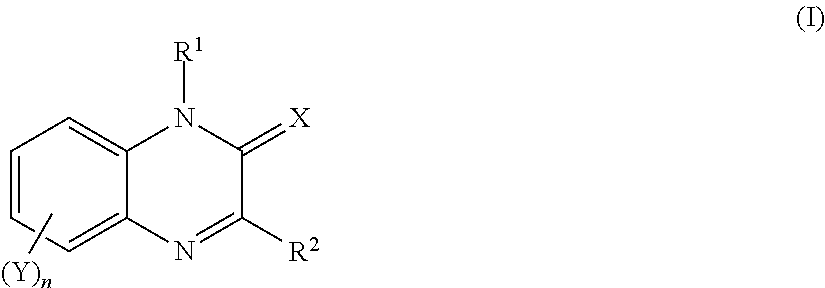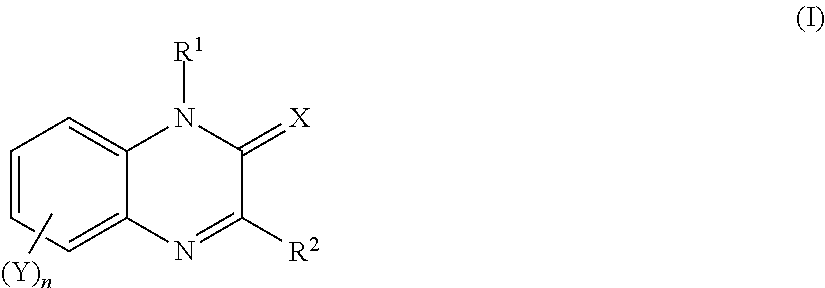Quinoxalin-2-one derivatives, compositions which protect useful plants and comprise these derivatives, and processes for their preparation and their use
a technology of quinoxalin and derivatives, applied in the field of dihydroquinoxalin2one derivatives, can solve the problems of reducing the efficacy of pesticides, known safeners may in many cases have disadvantages, and use of useful plants is often damaged to a greater or lesser extent, so as to achieve the effect of increasing the amount of formulation
- Summary
- Abstract
- Description
- Claims
- Application Information
AI Technical Summary
Benefits of technology
Problems solved by technology
Method used
Image
Examples
preparation examples
2. Preparation Examples
Example A
[0392]
1-Tetrahydrofurfuryl-3-(2-thienyl)-1,2-dihydroquinoxalin-2-one
[0393]A mixture of 1.00 g (4.4 mmol) of N-tetrahydrofurfuryl-o-phenylenediamine hydrochloride, 0.49 g (4.8 mmol) of triethylamine and 0.81 g (4.4 mol) of ethyl (2-thienyl)glyoxylate in 20 ml of ethanol was heated under reflux for 8 hours. The mixture was concentrated, the residue was taken up in water / dichloromethane and the organic phase was dried and concentrated. For purification, the residue was chromatographed on silica gel (ethyl acetate / heptane 1:1). This gave 0.22 g (16.0% of theory) of a slightly yellowish solid of melting point 123° C.
example b
[0394]
6,7-(Difluoromethylenedioxy)-3-phenyl-1,2-dihydroquinoxalin-2-one
[0395]A mixture of 1.25 g (4.79 mmol) of 4,5-(difluoromethylenedioxy)-o-phenylenediamine bishydrochloride, 1.07 g (10.53 mmol) of triethylamine and 0.79 g (4.79 mmol) of methyl phenylglyoxylate in 50 ml of methanol was heated under reflux for 8 hours. Even whilst still hot, the product precipitates as a colorless solid. After cooling, the product was filtered off with suction and the filter cake was washed with a little methanol. This gave 1.25 g of product (86.3% of theory) as a colorless solid of melting point 291-292° C.
example c
[0396]
6,7-(Difluoromethylenedioxy)-1-methyl-3-phenyl-1,2-dihydroquinoxalin-2-one
[0397]0.55 g (1.81 mmol) of 6,7-(difluoromethylenedioxy)-3-phenyl-1,2-dihydroquinoxalin-2-one (example B) and 0.65 g (5.49 mmol) of dimethylformamide dimethyl acetal in 25 ml of dimethylformamide was stirred at 95° C. for 8 hours. After cooling, the mixture was concentrated, the residue was taken up in dilute aqueous sodium hydroxide solution and dichloromethane and the organic phase was washed with water, dried and concentrated. For purification, the residue was chromatographed on silica gel (heptane / ethyl acetate 4:1). This gave 0.32 g of product (55.1% of theory) as a slightly yellowish solid of melting point 165° C.
PUM
| Property | Measurement | Unit |
|---|---|---|
| Ra* | aaaaa | aaaaa |
| chemical structures | aaaaa | aaaaa |
| stereoisomers | aaaaa | aaaaa |
Abstract
Description
Claims
Application Information
 Login to View More
Login to View More - R&D
- Intellectual Property
- Life Sciences
- Materials
- Tech Scout
- Unparalleled Data Quality
- Higher Quality Content
- 60% Fewer Hallucinations
Browse by: Latest US Patents, China's latest patents, Technical Efficacy Thesaurus, Application Domain, Technology Topic, Popular Technical Reports.
© 2025 PatSnap. All rights reserved.Legal|Privacy policy|Modern Slavery Act Transparency Statement|Sitemap|About US| Contact US: help@patsnap.com



